

A Guide to the Prompting Hierarchy in Speech Therapy
- allisonfors
- December 16, 2020
- Speech Therapy Education , Therapy Ideas
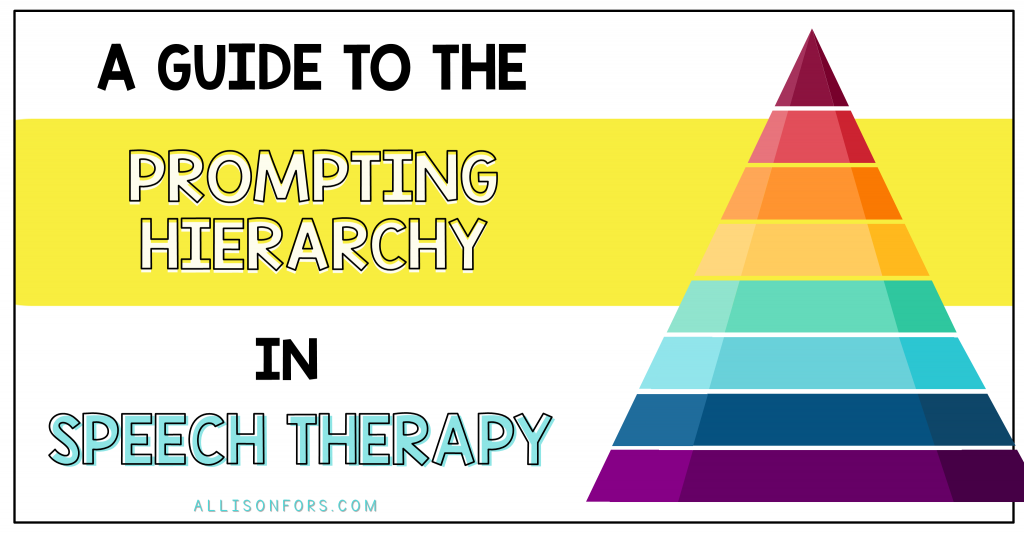
The prompting hierarchy is a structured, systematic method of assisting a person in learning new skills. It outlines the different ways we motivate our students to get the correct answer or achieve their goals. Prompt hierarchies provide many opportunities for communication. There are two different types of hierarchies: Most-To-Least and Least-To-Most.
Most-To-Least is used before a new skill is mastered. It provides a high level of support. This begins at the base of the hierarchy (physical assistance.)
Least-To-Most is used after a new skill is learned, and the person is working on mastery. This begins with the top of the hierarchy (pause.)
Choose the response latency time appropriate for your student (i.e. 30 seconds while you wait for a response) and if you don’t get the desired result, move onto the next prompt level in the hierarchy.
A Note about the Prompting Hierarchy
There are many different prompt hierarchies, and the one you choose and use is based on preference and your purpose. Most hierarchies are created for Augmentative and Alternative Communication (AAC). I highly recommend downloading and reading about Kate Ahern hierarchy. The big difference is physical assistance is not included. The reasoning for this is taking a child’s hand and moving it for them to communicate is not advisable. We want AAC users to know their voice is their own. Research has shown that modeling language on an AAC device is more effective than hand over hand or physical prompting. Kate Ahern says: “What does a hand-on, full physical “cue” tell the child? It tells them that: A) we have the right to manipulate their bodies or make them touch or do things whether they want to or not and B) that we have the right to force them to say things just because we want them to say it.”
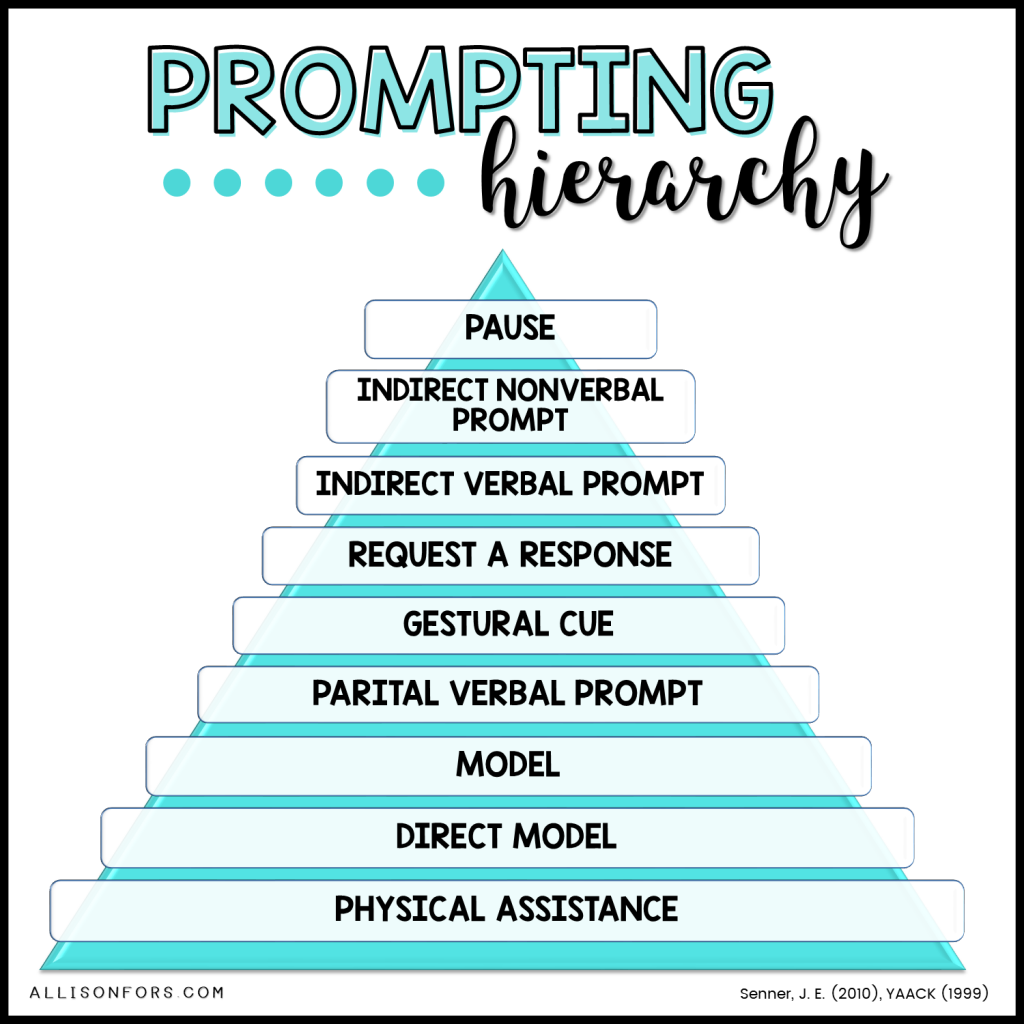
This infographic is available for free download.
The least invasive instructional support. Provide the person sufficient time to process the request and initiate communication with their own motivation. It is recommended to wait a minimum of ten seconds.
Indirect Nonverbal Prompt
Use your body language to show a form of communication is expected. Some examples include facial expressions, questions, hand motion, or eye contact.
Indirect Verbal Prompt
An indirect verbal prompt starts the student in the right direction without providing the answer. Often this is in the form of asking open-ended questions, which pushes them towards action, such as asking, “What happens next?” as they recount a story or, “Where does this piece go?” as they solve a jigsaw puzzle.
Request a Response
If there is still no response, try asking a specific question, such as “You need to ask me.” or “Tell me what you want.”
Gestural Cue
Use a gesture, such as pointing, reaching, or showing to let the person know what they are expected to do.
Partial Verbal Cue
Provide part of the verbal expected response, such as “You want the…”
Direct Model
If there is still not a response, model a potential response. Then pause and wait for the person to imitate or respond.
Physical Assistance
The most invasive instructional support. Provide hand-over-hand assistance.
You may be interested in the Speech-Language Development Handouts which includes a section on prompting!

Do you have any favorite strategies for using the prompting hierarchy?
2 Responses
Hi Allison, great post! I am an SLP as well beginning to gain experience working with AAC devices. Would you mind sharing the research article stating that modeling language on a device is better than providing physical prompts?
Thanks so much!
Hi! Biederman, G., Fairhall, J. L., Raven, K. A., & Davey, V. (1998). Teaching basic skills to children with Down Syndrome and developmental delays: The relative efficacy of interactive modeling with social rewards for benchmark achievements and passive observation. Down Syndrome Research and Practice, 5(1), 26-33. doi:10.3104/reports.72
Leave a Reply Cancel reply
Your email address will not be published. Required fields are marked *
You Also Might Like...

7 Prepositions Activities for Speech Therapy
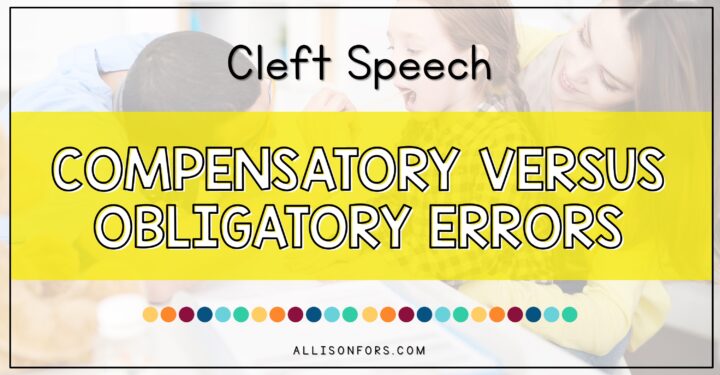
Compensatory Errors Versus Obligatory Errors in Cleft Speech
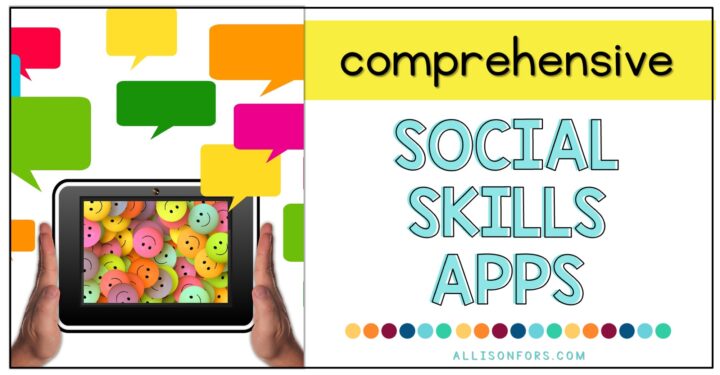
7 of the Most Comprehensive Social Skills Apps
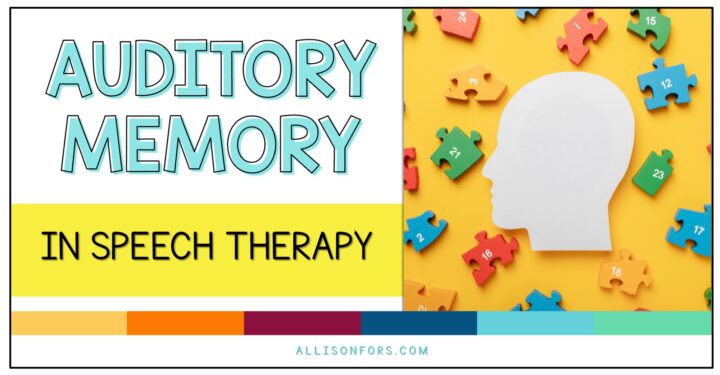
Auditory Memory and Processing in Speech Therapy

COPYRIGHT © 2024 · ALLISON FORS, INC.
TERMS & CONDITIONS
PRIVACY POLICY
Free to share
EARN CE CREDIT
You aren't currently signed up for CE credit. Want to learn more? Read here . Want to add CE credit to your account? Upgrade here
EXECUTIVE FUNCTIONS/MEMORY · BIRTH THROUGH HIGH SCHOOL
Add to list
There is no folder
Organizing executive function, Part One: Identifying and assessing for SLPs
Information geared toward slps on executive function is (ironically) anything but organized. here's a rundown of what slps need to know about ef basics and assessment..
January 7, 2023
The term “executive function” has gotten a lot of press lately. Clinically, we use it when a person is struggling to meet curricular, work, or social demands. This is a good thing because the reality is that executive function is involved in just about everything people do, and pretty much drives learning. Let’s look at what executive function is and the role SLPs and speech therapy play in serving people with executive function difficulties.
What is Executive Function?
Executive functions are the cognitive processes that help us filter, plan, and prioritize learning . Camuñas et al. called them “brain steering skills,” which could be a good definition to borrow in our work with younger kids. We set a goal, figure out and plan how to achieve that goal, and then execute our plan. We adjust and perfect the plan as we go along, and eventually, the new thing we’re learning becomes so automatic that it takes less cognitive energy to do it (mastery!). Put like that, it sounds so simple. But these are pretty involved processes that contain a lot of moving pieces and parts.
We can start by thinking of the specific skills included under the executive function umbrella. These are often included in direct measures of executive function (e.g., on cognitive tests), but they also find their way into many of our language tests (e.g., repetition tasks rely on working memory) and therapy activities.
- Attention . Attending to something. This includes orientation and sustained, selective, and divided attention.
- Working memory . Holding information in your mind and manipulating it as new information comes in.
- Shifting/flexibility . Switching tasks or shifting your thought process.
- Inhibition . Ignoring thoughts or details that are not important to the task at hand or stopping yourself from doing something that doesn’t fit the situation.

What does executive function have to do with therapy or IEP goals?
The smaller, more specific skills combine to help us do larger tasks , which we often consider part of executive functioning, too. We frequently see these in indirect measures of EF (e.g., parent, teacher, or self-reported measures). You might also see these pop up in IEP goals and objectives because they’re the functional skills SLPs and other interventionists address in educational and vocational settings:
- Task initiation
- Persistence, even when an activity is hard
- Self-regulation/self-monitoring, including re-evaluating your plan or goal as you go along
- Transitioning from one activity to the next
- Problem-solving
- Organization
- Time management
- Inferencing and critical thinking
The larger processes influence success in academic, vocational, and social settings as children become more independent. We can think of these as the “big picture” life skills that are often the overarching goals of educational and vocational training: reading/writing, meeting expectations at work, independently managing finances/a household, maintaining relationships, etc.
What are the signs of executive function deficits?
The items on these lists are all too familiar to SLPs because many of our clients and students have difficulty with them. ADHD , autism, language disorder , learning disability, TBI, and many other diagnoses are associated with executive function difficulties . In some cases, these difficulties can fly under the radar for a long time. Have you ever had a referral for a student who looks just fine on paper? You know, the kid whose grades don’t reflect what you see in your standardized testing? Or the student who is “smart, but just doesn’t apply themselves…if they would just try harder and stop being so lazy.” These are the kids who often miss out on services until they cross a threshold where they can no longer compensate for their difficulties. Studies indicate that college students with ADHD, for example, are at a much higher risk for academic probation, leaving college without a degree, and experiencing financial problems in adulthood.
From our clinical experiences, there are a few time points when executive function difficulties become more obvious. In clear clinical cases (e.g., kids who get diagnosed early), you might see signs in the toddler years related to social attention or attention to activities and initiating social interactions. This can look like either reduced or intense focus, or difficulty transitioning. But what is that?
Let’s take it back to those foundational skills–this kind of disorganization comes with difficulty inhibiting unimportant tasks in order to reorient and sustain attention to the important tasks (and/or remembering what you’re supposed to be doing in the first place). In more subtle presentations, these checkpoints are often related to increased expectations and independence (read: less external executive support from adults): 3rd/4th grade (and the transition from learning to read to reading to learn), and transitions to middle school, high school, and college.
Before we move on to assessment and treatment, we need to tackle one important question: Who is responsible for treating executive dysfunction?
If executive function skills are the foundation for learning, does this really fall into our scope, or is this an area SLPs should leave to other professionals? We’re stretched thin enough as it is (enough, in fact, that our own executive functioning is questionable at best on some days). The short answer is that EF touches just about everything a person does, so most educators have a role in assessing and supporting executive skill development. But EF skills are strongly related to language and communication, which means that SLPs are typically involved when a student exhibits executive dysfunction. To add to the IEP goal bank-esque list of larger skills we described above, elements of executive function influence language development, vocabulary, syntax, pragmatics, inferencing and predicting, following directions, answering questions, play, and social interactions . Clearly, these fall right into our scope, but our work will overlap with that of other members of the evaluation and intervention team. For example, self-monitoring can be practiced across multiple areas of the curriculum. And as we’ll see in our EF treatment review, it’s best practice to target these skills in functional and meaningful activities with repeated practice.
A note on hot versus cool executive function and the role of SLPs
Most of what we’ve talked about here is what's referred to as cool executive function . These skills are more in the academic realm and are likely addressed by teachers, intervention specialists, and ADHD coaches. Hot EF skills are related to emotional regulation, motivation, and affect , right within the scope of mental health professionals. Children who have difficulty with hot EF might struggle with controlling their emotions and persisting when a task is hard or dysregulating. SLPs tend to get involved in both hot and cool EF because both kinds are connected to language, social communication, and behavior.
Considerations for the assessment of executive function skills
We need to understand how executive function skills influence a person’s everyday activities to round out our usual assessments. In practice, school-based SLPs are usually interested in the functional processes rather than the discrete skills themselves. This makes sense—when the school psych begins explaining cognitive scores in an ETR meeting, you’re probably thinking about how you can translate that to school success rather than how to help your student master the Wisconsin Card Sort . In most cases, school teams can administer an indirect executive function test like the BRIEF , which will help highlight how EF skills affect the child at school and at home. See more in this research review on EF testing (including a link to a free tool).
All that said, SLPs assess executive functioning all the time! Language and EF are closely intertwined , and many of our language assessment tasks include elements of executive function. For example, tasks of listening comprehension or sentence repetition rely pretty heavily on working memory. We can also note our observations on attention, self-monitoring, and emotional regulation during the assessment process.
For more assessment ideas, this Perspectives piece by Jill Fahy (available for free to ASHA SIG members) discusses elements of executive function and walks you through what to consider as you plan and complete a comprehensive assessment. In addition to standardized testing, the paper suggests conducting classroom observations .
It also provides guidelines for developing activities that help you see a child’s executive function skills in action:
- Create a difficult but doable task. This could include planning recipes, outings, science experiments, or whatever is of interest to the child.
- Give your student a measurable end goal, but do not provide instructions on how to get there.
- Offer materials to complete the task. Some of these materials should be irrelevant or unrelated to the end goal.
- Let the student work it out! Don't step in to prevent your student from failing; they have the chance to use EF skills to address their problem. The skills they employ, or not, are important information for your assessment.
- Use your observation to build the student’s executive function profile in conjunction with your other assessments. What did you notice about attention, planning, inhibition, impulsivity, shifting, initiating, adaptations, and persistence in this functional task?
In Part Two (published June 2023) we'll discuss executive function goals, accommodations, and interventions! But this was lot of information, so let’s engage our executive function skills and summarize, shall we?
- Assess using a combination of standardized testing (including your language testing and any cognitive testing that was conducted), indirect assessment, informal tasks, and observations to note attention, memory, inhibition, and flexibility.
- Connect strengths and weaknesses to the student’s functional performance in daily activities.
- Apply what you’ve discovered to develop goals, determine accommodations, and plan interventions.

Are you new to The Informed SLP? Access our evidence database of over 3000 research reviews and earn CE credit as you go, starting at just $9/month. Learn more about The Informed SLP here .
Camuñas, N., Mavrou, I., Vaíllo, M., & Martínez, R. M. (2022). An executive function training programme to promote behavioural and emotional control of children and adolescents in foster care in Spain. Trends in Neuroscience and Education. https://doi.org/10.1016/j.tine.2022.100175
Fahy, J. (2014). Assessment of executive functions in school-aged children: Challenges and solutions for the SLP. Perspectives on School-Based Issues. https://doi.org/10.1044/sbi15.4.151
Fahy, J. K. & Browning, D. K. (2021). Adolescent language therapy: Syntax and semantics for reasoning and planning. Perspectives of the ASHA Special Interest Groups. https://doi.org/10.1044/2021_PERSP-21-00017
Friedman, L. & Sterline, A. (2019). A review of language, executive function, and intervention in autism spectrum disorder. Seminars in Speech and Language. https://doi.org/10.1055/s-0039-1692964
McDougal, E., Tai, C., Stewart, T. M., Booth, J. N., & Rhodes, S. M. (2022). Understanding and supporting Attention Deficit Hyperactivity Disorder (ADHD) in the primary school classroom: Perspectives of children with ADHD and their teachers. Journal of Autism and Developmental Disorders. https://doi.org/10.1007/s10803-022-05639-3
Senter, R., Chow, J. C., & Willis, E. C. (2022). Speech-language pathology interventions for children with executive function deficits: A systematic literature review. Language, Speech, and Hearing Services in Schools. https://doi.org/10.1044/2022_LSHSS-22-00013
Yu, Y., Li, H., Tsai, C., Lin, C., Lai, S., & Chen, K. (2020). Cool executive function and verbal comprehension mediate the relation of hot executive function and theory of mind in children with autism spectrum disorder. Autism Research. https://doi.org/10.1002/aur.2412
This review is free to share!
Executive Functions/Memory
Language Disorder
Screening/Prevention
Middle/High School
Free to Share
We pride ourselves on ensuring expertise and quality control for all our reviews. Multiple TISLP staff members and the original journal article authors are involved in the making of each review .
Retrieved from theinformedslp.com on 05/16/2024. The unauthorized copying, sharing or distribution of this copyrighted material is strictly prohibited.
See undefined Comment
Evidence-Based Blog and Materials for SLPs!
- $ 0.00 0 items

Teaching Hierarchy of Problem Solving Skills to Children with Learning Disabilities (Revised)
This revised handout explains the importance of analogical reasoning skills and offers suggestions for teaching the hierarchy of analogical problem-solving sub-components to language impaired children. It lists the “ Language Processing Hierarchy Pertaining to Critical Thinking” (Richard, 2001) as well as lists several FREE problem-solving apps and worksheets. References are provided.
- Reviews (2)
2 reviews for Teaching Hierarchy of Problem Solving Skills to Children with Learning Disabilities (Revised)
marie (verified owner) – October 17, 2015
Very helpful and informative.
Communication Station: Speech Therapy, PLLC (verified owner) – November 16, 2013
This product is a quick, simple introduction to teaching the executive function skill of problem solving for children with learning disabilities. It includes a number of additional resources for further reading as well as a basic hierarchical list of sub-skills to teach problem solving. SLPs, regular educators and special educators can benefit from this resource!
You must be logged in to post a review.
Related products

Freebie: Speech Language Assessment Checklist Sample for Preschool Children: 3:0-5:11 YEARS OF AGE

Executive Function Impairments in At-Risk Pediatric Populations

Introduction to Fetal Alcohol Spectrum Disorders (FASD)


13+ Problem Solving Goals Speech Therapy
Our children and students are constantly having to navigate a different social situation all day long. That’s why teaching our students problem solving skills can be very beneficial. To help make your job as a Speech-Language Pathologist a little bit easier I’ve gone ahead and gathered over 13 problem solving goals for speech therapy.
Currently, with my 4-year-old twin boys, I am constantly working on how they can use their problem solving skills to come up with creative ways to solve their own problems.
Luckily as a speech therapist, I had training in teaching problem solving skills and love teaching them new strategies to try.
Right now my boys’ favorite way to problem solve is to say, “3 more minutes. You set a timer mommy.” The funny part is they don’t realize they could ask me for even more time (at least not yet!).

IEP Goals – Problem Solving Goals Speech Therapy
If you’re on the hunt for a long-term goal for problem solving here is our list of goals to add to your goal bank.
1. Given a problem and problem solving graphic organizer, STUDENT will identify 3 solutions, and the 3 consequences of those solutions, then determine the best solution and explain why that is the best solution with 80% accuracy in 4 out of 5 opportunities.
2. Given a problem, STUDENT will appropriately identify the size of the problem with 80% accuracy in 4 out of 5 opportunities.
3. Given problems at differing sizes, STUDENT will identify the appropriate reaction size to the problem with 80% accuracy in 4 out of 5 opportunities.
4. Given a real-life or role-play scenario, STUDENT will demonstrate how to accept teacher help to make an appropriate decision during a conflict situation with 80% accuracy in 4 out of 5 opportunities.
5. Given a real-life or role-play conflict scenario, STUDENT will demonstrate appropriate peer mediation skills to resolve the conflict with 80% accuracy in 4 out of 5 opportunities.
6. Given a real-life or role-play conflict scenario, STUDENT will remain calm and relaxed, listen to the other person, and determine what they can agree on with 80% accuracy in 4 out of 5 opportunities.
7. Given criticism or feedback, STUDENT will look at the person, say “okay”, and not argue with 80% accuracy in 4 out of 5 opportunities.
8. Given a problem, STUDENT will define exactly what the problem is, brainstorm possible options, consider the disadvantages and advantages of options, and choose the best option with 80% accuracy in 4 out of 5 opportunities.
9. Given a defeat or loss in a game, STUDENT will look at the person who won , remain calm, and congratulate the other person with 80% accuracy in 4 out of 5 opportunities.
10. Given an upsetting situation, STUDENT will express HIS/HER anger with non-aggressive words to describe how HE/SHE feels with 80% accuracy in 4 out of 5 opportunities.
11. Given a time when the student is angry, STUDENT will use a calming strategy (e.g., breathe slowly, take a break, count to 10, listen to music, etc.) with 80% accuracy in 4 out of 5 opportunities.
12. Given a warning and a change in routine, STUDENT will identify exactly what is changing, ask questions, remain calm, and explain HIS/HER feelings of concern with 80% accuracy in 4 out of 5 opportunities.
13. Given a warning and a change in routine, STUDENT will accept the change without becoming upset with 80% accuracy in 4 out of 5 opportunities.
14. Given a social interaction, STUDENT will identify HIS/HER emotion and why HE/SHE is feeling that way with 80% accuracy in 4 out of 5 opportunities.
Social Communication Skills – IEP Goals
Do you have students working on other social skills goals or language skills? If so, you might want to check out my other goal banks. Here are a few of the goals you would find in my massive 432 iep goal bank :
- Facial expressions
- Conversational exchange or conversational turns
- Body language
- Follow-up questions
- Expressive Language
- Wh questions or Answer questions
- Word Level, Phrase Level, and Sentence Level
- Social pragmatic goals
- Communication Device – Nonverbal communication
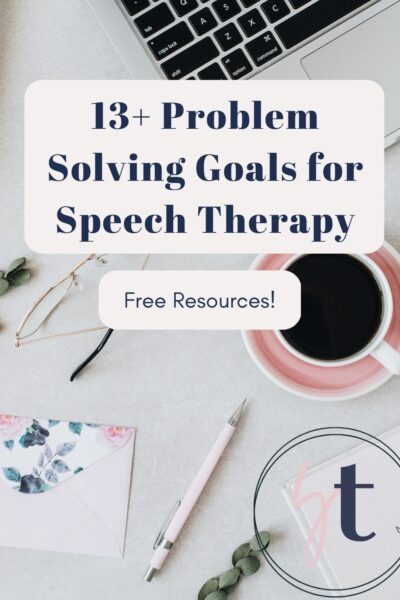
Short-Term Goals – Speech Therapy Goals
I know every district and even school setting has different ways it requires the goal writing of their objectives to be written, but typically my district wanted us to reduce either the number required or the percentage of achievement.
Here are a few examples to help get you started.
If we take a sample goal:
“Given a problem and problem solving graphic organizer, STUDENT will identify 3 solutions, the 3 consequences of those solutions, then determine the best solution, and explain why that is the best solution with 80% accuracy over 3 out of 4 consecutive sessions.”
- Reduced Number or Trials Required: The objective might be, “Given a problem and problem solving graphic organizer, STUDENT will identify 2 solutions, the 2 consequences of those solutions, then determine the best solution, and explain why that is the best solution with 80% accuracy over 3 out of 4 consecutive sessions.”
- Reduce Percentage of Accuracy: The objective might be, “Given a problem and problem solving graphic organizer, STUDENT will identify 3 solutions, the 3 consequences of those solutions, then determine the best solution, and explain why that is the best solution with 70% accuracy over 3 out of 4 consecutive sessions.”
- Reduce Difficulty of Task: The objective might be, “Given a problem and problem solving graphic organizer, STUDENT will pick from a selection of choices 2 possible solutions, the 2 possible consequences of those solutions, then determine the best solution, and explain why that is the best solution with 80% accuracy over 3 out of 4 consecutive sessions.”
- Reduce Number of Sessions of Accuracy: The objective might be, “Given a problem and problem solving graphic organizer, STUDENT will identify 3 solutions, the 3 consequences of those solutions, then determine the best solution, and explain why that is the best solution with 80% accuracy over 2 out of 4 consecutive sessions.”
(Meaning out of 4 therapy sessions in a row. They identified 3 possible solutions, the 3 consequences of those solutions and then determined the best solution in 2 out of 4 or 50% of the time in order to mark that goal mastered.)
As the speech pathologist, you are the specialist and you know your students’ communication disorders and child’s ability best though, so just take the functional goals from above and simplify them into achievable steps for your specific student.
SEE ALSO: 31 Best Wordless Videos to Teach Problem Solving
Data collections – problem solving goals speech therapy.
If you’re a speech therapist or have classroom teachers in need of data tracking forms while working on your student’s social interaction skills for speech therapy then be sure to check out my IEP goal data tracking for progress monitoring forms .
Or if you simply want a list of data sheets to choose from then be sure to check out my list of 35 free speech therapy data sheets roundup .

Visual Cue – Problem Solving Goals Speech Therapy
I always love using visual cues with my students. It can really help teach a concept that can be overwhelming.
Here is my problem solving graphic organizer that helps teach problem solving. As your child or student fills out the form you can start by providing helpful verbal prompts and hopefully, the more they work on their problem solving skills and will need less prompts.
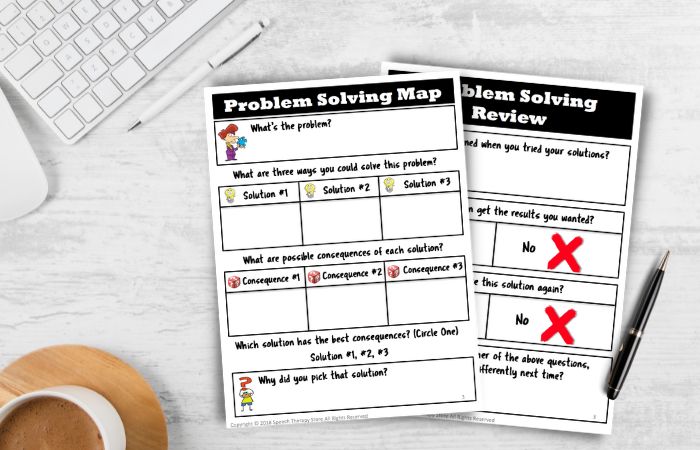
Here are all my blog posts about problem solving that you might also find helpful!
31 Best Wordless Videos to Teach Problem Solving – Watch the fun short youtube videos and then help solve the hypothetical problems.

71+ Free Social Problem-Solving Scenarios – Read the scenarios and practice solving the problems using the helpful graphic organizer pages.
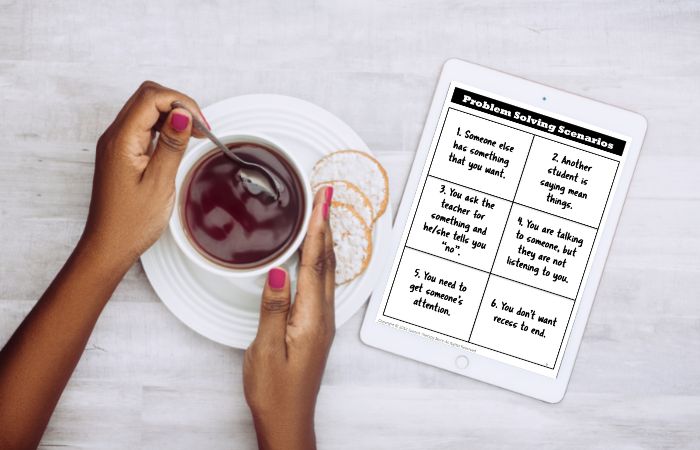
Problem Solving Wheel: Help Kids Solve Their Own Problems – Use our problem solving wheel or make your own individualized problem solving wheel for your specific student.
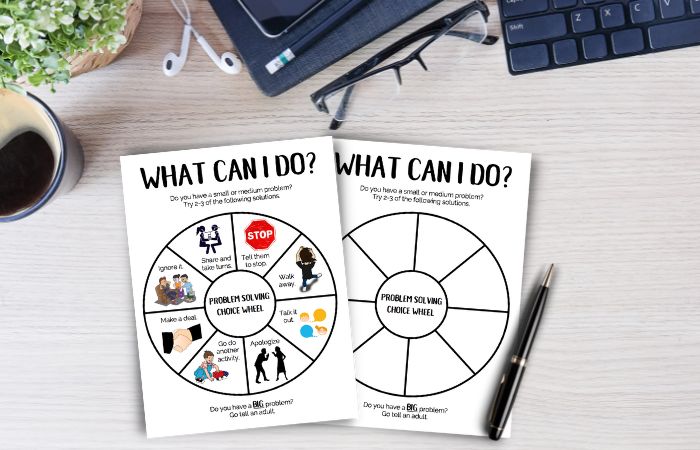
High School Students
The most important thing we can teach our high school aged students is how to advocate for themselves during their school day within a social setting.
Inside my tpt store I have a self-advocacy lesson to practice solving their school life problems in a functional way. Have your students grab a communication partner and get started!
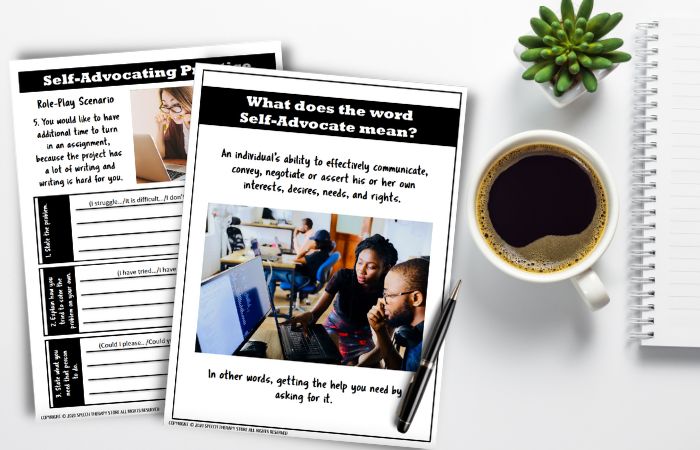
In addition to the self-advocacy lesson plan I also have a phone call lesson plan in my tpt store for making phone calls in the workplace or everyday life, such as calling the pharmacy or dentist’s office.
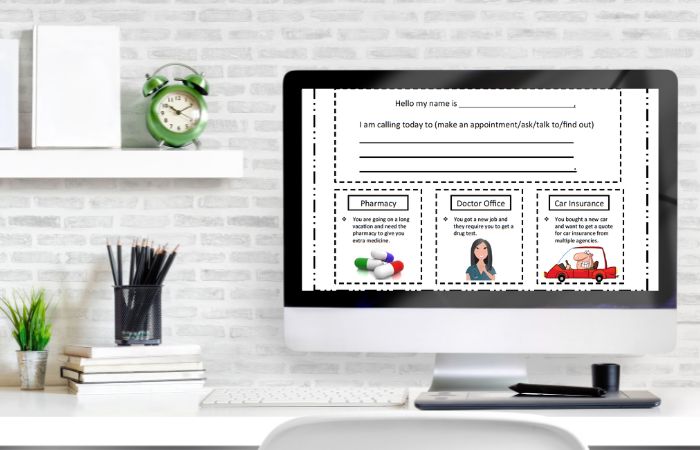
SEE ALSO: 71+ Free Social Problem-Solving Scenarios
Younger children.
Currently inside of my tpt store I have a problem size and reaction size lesson plan to help our younger children understand that problems are of different sizes and therefore different reaction sizes.
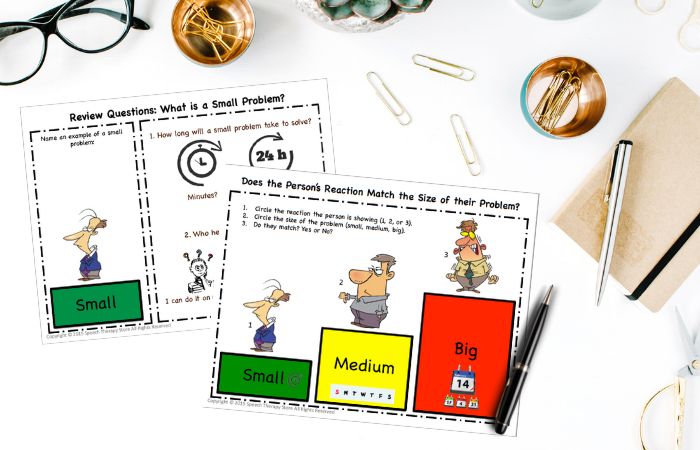
Another great problem solving resource in my tpt store is my problem solving restorative justice graphic visual to help children review their own feeling along with how the other person might have felt and then solve their problem.
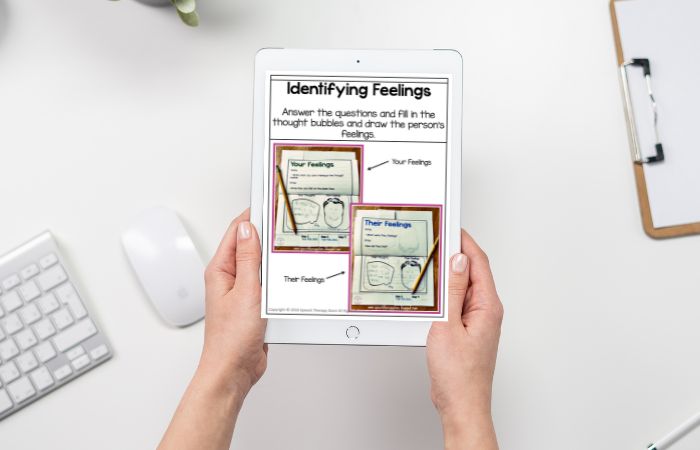
Picture Scene
- Social Scene Set 1 , Set 2 , Set 3 , Set 4 , Set 5 , & Set 6 by Contrary Chrissy – are different social scenes along with questions for problem solving.
- Back to School Social Language and Problem Solving Printable by Aimee Walton – includes different scenarios along with questions to help guide the student in solving the problem.
SEE ALSO: Problem Solving Wheel: Help Kids Solve Their Own Problems
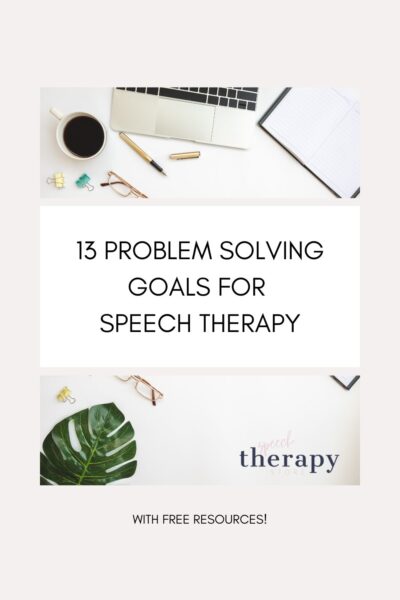
Social Conversation
If you’re looking for conversational skills to keep your middle school and high school aged students engaged, asking follow-up questions, or working on generalizing their skills across multiple settings you’ll want to check out the following blog posts.
These ideas are perfect for working in a small group setting on your student’s functional communication skills.
- Ideas to Help Keep Your Middle/High School Students Engaged – This post reviews 5 different strategies you can use to help keep your students engaged, such as using real life photos instead of little kid graphics and using materials at different levels allowing everyone to access the resources at their individual level.
- Ideas to Maintain a Conversation with Follow-Up Questions – Read how I help middle/high school students work on their social pragmatics of maintaining a conversation by using fun and interesting materials appropriate for their age.
- Ideas to Help Students Generalize Their Conversational Skills – Learn how I use self-rating forms to work on my student’s pragmatic language goals of generalizing their conversational skills across multiple settings and with multiple different people.
Short Story
- Inferencing and Problem-Solving FREEBIE by SLP to go – This resource is perfect for older students who are working on any of the following skills: inferencing, problem-solving, predicting, role-playing, or maintaining a conversation.
- Social Skills Problem Solving: Fighting with Friends by Let’s Build Language- Jaclyn Watson – Grab this freebie to help your students problem solve social challenges around fighting with friends.
In Conclusion: Problem Solving Goals Speech Therapy
I hope you found this list of problem solving goals to be helpful along with the resources.
Wishing you a wonderful year ahead!
Want Even More Problem Solving Goals Speech Therapy?
- 31 Best Wordless Videos to Teach Problem Solving
- 71+ Free Social Problem-Solving Scenarios
- Problem Solving Wheel: Help Kids Solve Their Own Problems
- 917+ Best Free Boom Cards for Speech Therapy
- 432+ Free Measurable IEP Goals and Objectives Bank
Want the Best of the Bests?
Be sure to check out our most popular posts below!
- 21 Best Reinforcement Games for Speech Therapy / Teletherapy
- Best IEP Resources
- 430+ Free Multisyllabic Words List Activity Bundle
- 279+ Free Speech Therapy Digital Materials
- 179+ Free Speech Therapy Wh-Questions Printable
Join Pilot Waitlist

Home » Blog » General » Enhancing Problem-Solving Abilities with Speech Therapy Techniques

Enhancing Problem-Solving Abilities with Speech Therapy Techniques
Welcome to my blog! In today’s post, we will explore the importance of problem-solving abilities in daily life and how speech therapy techniques can enhance these skills. Whether you are a parent, teacher, or individual looking to improve problem-solving abilities, this blog post will provide you with valuable insights and practical tips.
Understanding Problem-Solving Abilities
Before we delve into the role of speech therapy in enhancing problem-solving abilities, let’s first understand what problem-solving entails. Problem-solving is the cognitive process of finding solutions to challenges or obstacles we encounter in our daily lives. It involves analyzing the situation, identifying possible solutions, and selecting the most effective course of action.
Key components of problem-solving abilities include critical thinking, decision-making, creativity, and flexibility. These skills are essential for navigating various aspects of life, such as academics, work, relationships, and personal growth. Difficulties in problem-solving can impact an individual’s social-emotional well-being, leading to frustration, low self-esteem, and interpersonal conflicts.
Role of Speech Therapy in Enhancing Problem-Solving Abilities
Speech therapy is a holistic approach that addresses communication and cognitive-linguistic skills. By targeting these areas, speech therapy can significantly enhance problem-solving abilities. Let’s explore some of the speech therapy techniques that can be used to improve problem-solving skills.
Communication Skills Development
Effective communication is a crucial aspect of problem-solving. Speech therapy techniques can help individuals develop the necessary communication skills to express their thoughts, ideas, and concerns clearly. This includes improving articulation and phonological skills, enhancing language comprehension and expression, and developing pragmatic language abilities.
Articulation and phonological exercises focus on improving speech sound production, ensuring that individuals can communicate their ideas clearly. Language comprehension and expression activities help individuals understand and use language effectively, enabling them to express their thoughts and understand others’ perspectives. Pragmatic language training teaches individuals the social rules and conventions of communication, such as turn-taking, active listening, and nonverbal cues.
Cognitive-Linguistic Exercises
Cognitive abilities play a significant role in problem-solving. Speech therapy techniques can target cognitive skills such as memory, attention, sequencing, and categorization. These exercises help individuals improve their cognitive abilities, enabling them to think critically, analyze information, and generate creative solutions.
Memory and attention exercises enhance an individual’s ability to retain and recall information, allowing them to process and analyze complex problems effectively. Sequencing and categorization tasks develop logical thinking and organization skills, enabling individuals to break down problems into manageable steps. Problem-solving games and puzzles provide opportunities for individuals to practice their cognitive skills in a fun and engaging way.
Executive Functioning Training
Executive functions are a set of cognitive processes that enable individuals to plan, organize, initiate, and self-regulate their behavior. These skills are essential for effective problem-solving. Speech therapy techniques can target executive functioning skills, helping individuals develop strategies to improve planning, organization, time management, and self-regulation.
Planning and organization activities teach individuals how to break down tasks, set goals, and create action plans. Time management and prioritization exercises help individuals manage their time effectively and prioritize tasks based on importance. Self-regulation strategies focus on developing emotional control, impulse control, and flexibility, enabling individuals to approach problem-solving with a calm and focused mindset.

Social Skills Training
Social skills are vital for collaborative problem-solving, as it often involves working with others to find solutions. Speech therapy techniques can target social skills, helping individuals develop the necessary interpersonal skills to collaborate effectively, understand others’ perspectives, and regulate their emotions.
Role-playing and social scenarios provide individuals with opportunities to practice problem-solving in realistic social situations. Perspective-taking exercises help individuals understand different viewpoints, fostering empathy and cooperation. Emotional regulation strategies teach individuals how to manage their emotions during problem-solving, ensuring that they can approach challenges with a calm and rational mindset.
Problem-solving abilities are essential for navigating various aspects of life, and speech therapy techniques can significantly enhance these skills. By targeting communication skills, cognitive abilities, executive functioning, and social skills, speech therapy provides individuals with the necessary tools to approach problem-solving with confidence and success.
If you or someone you know is struggling with problem-solving abilities, I encourage you to seek professional help from a speech-language pathologist. They can provide personalized guidance and support to help individuals enhance their problem-solving skills and improve their overall social-emotional well-being.
Start your EverydaySpeech Free trial today and embark on a journey to enhance your problem-solving abilities through speech therapy techniques. Visit https://everydayspeech.com/start-free-trial/ to get started!

Related Blog Posts:
Pragmatic language: enhancing social skills for meaningful interactions.
Pragmatic Language: Enhancing Social Skills for Meaningful Interactions Pragmatic Language: Enhancing Social Skills for Meaningful Interactions Introduction: Social skills play a crucial role in our daily interactions. They enable us to navigate social situations,...
Preparing for Success: Enhancing Social Communication in Grade 12
Preparing for Success: Enhancing Social Communication in Grade 12 Key Takeaways Strong social communication skills are crucial for academic success and building meaningful relationships in Grade 12. Social communication includes verbal and non-verbal communication,...
Preparing for Success: Enhancing Social Communication in Grade 12 Preparing for Success: Enhancing Social Communication in Grade 12 As students enter Grade 12, they are on the cusp of adulthood and preparing for the next chapter of their lives. While academic success...

FREE MATERIALS
Better doesn’t have to be harder, social skills lessons students actually enjoy.
Be the best educator you can be with no extra prep time needed. Sign up to get access to free samples from the best Social Skills and Social-Emotional educational platform.
Get Started Instantly for Free
Complete guided therapy.
The subscription associated with this email has been cancelled and is no longer active. To reactivate your subscription, please log in.
If you would like to make changes to your account, please log in using the button below and navigate to the settings page. If you’ve forgotten your password, you can reset it using the button below.
Unfortunately it looks like we’re not able to create your subscription at this time. Please contact support to have the issue resolved. We apologize for the inconvenience. Error: Web signup - customer email already exists
Welcome back! The subscription associated with this email was previously cancelled, but don’t fret! We make it easy to reactivate your subscription and pick up right where you left off. Note that subscription reactivations aren't eligible for free trials, but your purchase is protected by a 30 day money back guarantee. Let us know anytime within 30 days if you aren’t satisfied and we'll send you a full refund, no questions asked. Please press ‘Continue’ to enter your payment details and reactivate your subscription
Notice About Our SEL Curriculum
Our SEL Curriculum is currently in a soft product launch stage and is only available by Site License. A Site License is currently defined as a school-building minimum or a minimum cost of $3,000 for the first year of use. Individual SEL Curriculum licenses are not currently available based on the current version of this product.
By clicking continue below, you understand that access to our SEL curriculum is currently limited to the terms above.
- Support My Website

Sunlight Speech Therapy
A place to seek sunlight about speech, language, cognition, and dysphagia

Goal Bank Speech Therapy for SNF
Goal Bank for speech therapists working in a skilled nursing facility. Goals for Cognition, Memory, Attention, Problem Solving, Aphasia, Dysarthria, Voice, Swallowing, Tracheostomy, and Skilled Maintenance. For an all in one download please see end of document.
ST Goal Bank
Cuing Hierarchy
Independent
Setup/cleanup assistance
Supervision or touching assistance
Partial/mod assist
Substantial/maximal assistance
- Pt will complete further cognitive assessment (SLUMS/RIPA/ALFA/ACA) in order to assess cognitive communication skills by (DATE).
- Pt will be able to verbally express compensatory strategies to improve cognition in order to return to PLOF.
Long-Term Goal
- Pt will increase memory abilities to (independence/setup/supervision/mod assist/max assist/dependent) demonstrating improved (orientation, basic functional recall of everyday activities, biographical information, safety precautions) in order to (return to PLOF/increase independent on nursing unit).
- Pt will increase memory to (independence/setup/supervision/mod assist/max assist/dependent) demonstrating independence with (functional memory tasks, use of compensatory strategies and precautions, recall of medication schedule) in order to (return to PLOF/increase independence on nursing unit).
Short-Term Goal
- Pt will complete further memory assessment with (SLUMS/RIPA) in order to determine current cognitive level and goal set appropriately.
- Pt will utilize memory book with ___% accuracy with (independence/setup/supervision/mod assist/max assist) in order to assist with everyday functional recall.
- Pt will utilize external/internal memory strategies to solve functional (immediate/short-term/working) memory tasks at (independence/setup/supervision/mod assist/max assist) with ___% accuracy to return to PLOF.
- Pt will complete (alternating/sustained/selective) attention activities with (independence/setup/supervision/mod assist/max assist/dependent) in order to increase independence with functional activities.
- Pt will complete alternating attention tasks with ___% accuracy given (independence/setup/supervision/mod assist/max assist/dependent) cues to attend in a noisy environment in order to increase independence during functional tasks.
- Pt will sustain attention to (visual information/auditory information/activity) for ___ minutes in a quiet environment given (independence/setup/supervision/mod assist/max assist/dependent) to increase independence during functional tasks.
- Pt will selectively attend to (visual/auditory information/activity) for __ minutes given (independence/setup/supervision/mod assist/max assist/dependent) to attend to functional activities.
PROBLEM SOLVING
- Pt will demonstrate problem solving skills with (independence/setup/supervision/mod assist/max assist/dependent) or higher, demonstrating improved (insight, safety, executive functioning, reasoning, functional problem solving) in order to return to (IADL’s, increase independence on nursing unit).
- Pt will demonstrate problem solving skills with (independence/setup/supervision/mod assist/max assist/dependent) or higher, demonstrating improve problem solving required for independence with basic ADL’s and safety.
- Pt will complete ALFA assessment in order to determine patients’ problem-solving functioning to goal set appropriately.
- Pt will complete basic problem-solving tasks related to safety (use of call light/walker/O2 precautions) at __% accuracy with (independence/setup/supervision/mod assist/max assist/dependent) cues in order to (return to PLOF/increase independence on nursing unit).
- Pt will sequence functional activities with ___% with (independence/setup/supervision/mod assist/max assist/dependent) in order to (return to PLOF/increase independence on nursing unit).
- Pt will complete higher-level problem-solving tasks r/t IADL’s at ___% accuracy given (independence/setup/supervision/mod assist/max assist/dependent) cues in order to (return to PLOF).
SOCIAL INTERACTION
- Pt will increase social interaction to (independence/setup/supervision/mod assist/max assist/dependent) demonstrating increased ability to (manage emotions, cope, engage in social communication, maintain topic, use appropriate pragmatics, turn-take).
- Pt will increase social interaction to (independence/setup/supervision/mod assist/max assist/dependent) or higher demonstrating improved (behavior, pragmatics, eye contact, emotional regulation, coping with anxiety/depression.
- Caregivers/Staff will be able to teach back pt behavioral plan to manage (agitation/restlessness/anxiety/depression) in order to improve quality of care.
- Pt will demonstrate techniques of emotional regulation to manage negative ideation and behavior (deep breathing, positive thinking, mindfulness) with (independence/setup/supervision/mod assist/max assist/dependent in order to benefit quality of life.
- Pt will communicate in social interactions given (independence/setup/supervision/mod assist/max assist/dependent) for (turn taking, eye contact, pragmatics, appropriateness) in order to increase appropriate social interactions with staff/residents/family.
APHASIA RECEPTIVE
- Pt will demonstrate (verbal/written) expression skills with (independence/setup/supervision/mod assist/max assist/dependent) concerning improved (motor speech, word finding, fluency, voice, initiation, pragmatics) in order to express (simple wants/needs/higher level/complex ideas).
- Pt will answer simple biographical yes/no questions presented (verbally/visually) with ___% accuracy with (independence/setup/supervision/mod assist/max assist/dependent) cues in order to increase ability to communicate simple biographical information.
- Pt will follow (simple/complex 1-step commands/2-step commands) with ___% accuracy given (independence/setup/supervision/mod assist/max assist/dependent) cues in order to increase ability to complete functional tasks.
- Pt will identify the correct picture in a field of (2/4/6) when presented with the word (verbally/visually) at ___% accuracy given (independence/setup/supervision/mod assist/max assist/dependent) cues in order to increase ability to recognize functional language.
- Pt will read (sentences/paragraphs) and answer comprehension questions with ___% accuracy given (independence/setup/supervision/mod assist/max assist/dependent) cues in order to improve functional communication.
APHASIA EXPRESSIVE
Long-Term Goals
- Pt will be able to communicate using (simple/complex) (words/phrases/sentences) with ( independence/setup/supervision/mod assist/max assist/dependent) in order to increase ability to express (simple/complex) (wants/needs/ideas/feelings).
Short-Term Goals
- Pt will name common objects at __% accuracy with (independence/mod assist/max assist) given (phonemic/orthographic/semantic) cues in order to increase ability to express wants/needs.
- Pt will generate sentences with 3 or more words in response to a situation with __% accuracy with (independence/mod assist/max assist) given (phonemic/orthographic/semantic) in order to increase ability to communicate basic wants and needs.
- Pt will participate in (simple/complex) conversation with ___% accuracy with situation with __% accuracy with (independence/mod assist/max assist) given (phonemic/orthographic/semantic) in order to increase ability to communicate complex thoughts, feelings, and needs.
- Pt will produce (vowels/phrases/paragraphs/conversation) with appropriate intelligibility given (independence/setup/supervision/mod assist/max assist/dependent) cues in order to increase ability to express wants and needs.
- Pt will produce (vowels/phrases/paragraphs) with appropriate voicing in ___% of opportunities given ( independence/setup/supervision/mod assist/max assist/dependent) cues in order to increase ability to express wants and needs.
- Pt will produce phrases with (5 or fewer words/7 or more) in one breath in __% of opportunities with (independence/setup/supervision/mod assist/max assist/dependent) cues in order to increase ability to express wants/needs.
- Pt will produce phrases with appropriate stress in __% of opportunities given ( independence/setup/supervision/mod assist/max assist/dependent) cues in order to increase ability to express wants/needs.
- Pt will produce (words/phrases) with appropriate voicing with (independence/setup/supervision/mod assist/max assist/dependent) in order to express wants/needs.
- Pt will produce (easy onset/non-nasal/tense vowels/minimal pairs) words with appropriate voicing in ___% of opportunities with ( independence/setup/supervision/mod assist/max assist/dependent) cues in order to increase ability to express wants/needs.
- Pt will produce (words/phrases) at (70dB/80dB) vocal loudness with ( independence/setup/supervision/mod assist/max assist/dependent) cues in order to increase ability to express wants/needs.
- Pt will improve MPT to __ml with (independence/setup/supervision/mod assist/max assist/dependent) to demonstrate increased breath support req for voicing.
COMPREHENSION
- Pt will d/c with ( independence/setup/supervision/mod assist/max assist/dependent) in order to increase comprehension (reading/expression) of (simple/complex) ideas and instruction.
- Pt will d/c with ( independence/setup/supervision/mod assist/max assist/dependent) (reading/expression) in order to increase comprehension of functional information.
- Pt will follow (1/2/3) step directions at ( independence/setup/supervision/mod assist/max assist/dependent) level with ___% accuracy in order to complete functional activities.
- Pt will respond to (simple/complex) questions at ( independence/setup/supervision/mod assist/max assist/dependent) level with __% accuracy in order to increase ability to participate in functional communication.
- Pt will respond to (simple/complex) questions at independent level with __% accuracy demonstrating improved auditory processing/comprehension
- Pt will answer paired Y/N questions at with __% accuracy at ( independence/setup/supervision/mod assist/max assist/dependent) in order to increase ability to participate in functional communication.
- Pt will identify (object/pic/word) in a field of (2/4/6) with ___% accuracy with (independence/setup/supervision/mod assist/max assist/dependent) in order to participate in functional activities.
Pt will be able to use (low tech/high tech) AAC device with (independence/setup/supervision/mod assist/max assist/dependent) cues in order to communicate basic wants/needs.
Pt will (type/identify) single (words/icons) with ___% accuracy given ( independence/setup/supervision/mod assist/max assist/dependent) cues in order to communicate basic wants/needs.
Pt will answer simple biographical questions at __% accuracy given (independence/setup/supervision/mod assist/max assist/dependent) cues in order to increase functional communication.
Pt will be able to navigate device with ___% accuracy given ( independence/setup/supervision/mod assist/max assist/dependent) cues in order to increase independence with device.
Pt will be able to add new (icons/vocabulary) to AAC device with ___% accuracy with (independence/setup/supervision/mod assist/max assist/dependent) cues in order to increase functional communication.
- Pt will d/c on IDDSI diet of (Regular-7/Easy to Chew-7b/Soft and Bite Size-6/Minced and Moist-5/Puree-4) (Thin/Nectar Thick) liquids) with (independence/setup/supervision/mod assist/max assist/dependent) use of swallow strategies in order to improve (oral/pharyngeal) swallowing safety and improve (nutrition/hydration)
- Pt will d/c on PO diet maintaining nutritional needs PO requiring no alternative means of nutrition (IV/PEG/NG).
- Pt/caregiver will demonstrate/verbalize understanding of diet recommendations, swallowing strategies, swallowing exercises for (home/facility) maintenance program.
- Pt will complete instrumental swallow evaluation to assess swallow function and determine appropriate diet level.
- Pt/caregiver will demonstrate understanding of oral care and be able to follow oral care program with (independence/setup/supervision/mod assist/max assist/dependent) in order to benefit oral health.
- Pt will decrease (oral pocketing/anterior labial spillage) with ___% accuracy with (independence/setup/supervision/mod assist/max assist/dependent) to reduce risk of aspiration.
- Pt will manage trials of (Regular-7/Easy to Chew-7b/Soft and Bite Size-6/Minced and Moist-5/Puree-4) following swallowing strategies with ___% accuracy with (independence/setup/supervision/mod assist/max assist/dependent) in order to decrease s/s of aspiration.
- Pt will complete (pharyngeal/oral motor exercises) with (independence/setup/supervision/mod assist/max assist/dependent) in order to increase swallow function.
TRACH/DECANNULATION
Secretion Management/Suctioning Goal
- Pt will independently manage secretions as demonstrated by requiring no suction (deep or oral suction) over __hr period.
- Pt will utilize quad cough at spv level to clear deep secretions and req no deep suction over __hr period.
- Pt with demonstrate ability to clear pharyngeal secretions without need for deep suction over __period.
- Pt will independently utilize yanker to clear oral secretions
- Pt will decrease anterior spillage of saliva req __ cueing to clear secretions
- Pt will increase awareness of drooling req __ cues in __ min/sessions to wipe/mng secretions
- Pt will improve labial seal in order to decrease anterior spillage of secretions by meeting IOPI peak of __ kPa when measuring lip strength
- Pt will improve lingual strength req to mng secretions as demonstrated by IOPI peak of __kPa when measuring base of tongue strength.
DECANNULATION
- Pt will meet decannulation goals in order to increase independence to return to PLOF.
- Pt will tolerate uncuffed trach for __ hrs/days in order to demonstrate readiness for passy muir speaking valve
- Pt will down size to _ size trach in order to tolerate PMSV/demonstrate readiness for capping trials
- Pt will tolerate PMSV for __hrs in order to increase independence with verbal communication
- Pt will tolerate PMSV for __hrs in order to demonstrate readiness for capping trials and decannulation
- Pt will tolerate capping trials for __min/hrs in order to work towards decannulation
- Pt will be decannulated in order to improve swallow function/in order to improve verbal communication
- Pt and family will demonstrate understanding of trach related goals
- Pt/family will demonstrate understanding of trach/pmsv care (placement/clearing)
- Pt will meet incentive spirometer peak of __ ml to demonstrate improved breath support req for decannulation
- Pt will meet __ syllables per breath over 3 trials demonstrating improved breath support req for decannulation
- Pt will meet MPT of ___ sec over 3 trials to demonstrate breath support req for decannulation
- Pt will digitally occlude (stoma/trach) to improve breath support req for intelligible speech at __ level.
SKILLED MAINTENANCE
- Pt will maintain cog/communication skills at level of (independence/setup/supervision/mod assist/max assist/dependent) with implementation of __% verbal cues and environmental modifications to decrease risk of cognitive decline.
- Pt will maintain comprehension skills at (independence/setup/supervision/mod assist/max assist/dependent) with implementation of min cues during discussion of familiar topics to decrease risk of social isolation and to facilitate communication opportunities.
- Pt will maintain current diet with pleasure feedings with SLP in order to benefit quality of life.
- Pt will maintain safe swallow function while consuming (thin liquids/texture) by (spoon/cup/straw) with SLP only for pleasure feedings.
- Pt will continue to engage in 3-minute social interactions with staff during daily care in order to maintain communication skills.
- Pt will maintain short-term memory skills using a memory book and verbal cues from staff in 80% of opportunities.
- Pt will maintain ability to recall self-relevant pieces of information at __% accuracy with verbal/visual cues to maintain ability to recall events and leisure activities scheduled.
- Pt will maintain current reasoning skills at ___% accuracy and occasional (min/mod) cues to prevent cognitive decline and to maintain independence within this environment.
- Pt will maintain thought organizational skills at __% accuracy and occasional cues with task modifications as needed to prevent cognitive decline within this environment.
- Pt will maintain ability to respond to yes/no questions at __% accuracy with implementation of verbal cues to increase ability to engage in meaningful interactions.
- Pt will demonstrate ability to use verbal and non-verbal communication to make decisions related to preferences during care tasks and daily routine with (independence/setup/supervision/mod assist/max assist/dependent) to facilitate highest level of independence in current environment.
- Pt will maintain ability to complete 3 conversational exchanges related to direct and observable topics using multisensory stimuli in order to reduce risk of social isolation.
- Pt will maintain current level of cognitive-communication to actively participate (following along with handout, switching between tasks, singing along, etc) in weekly activity with (independence/setup/supervision/mod assist/max assist/dependent) in order to maintain quality of life and highest level of independence with leisure activities of choice.
Share this:
You might also like.

Dementia Goal Bank for Speech Therapy

Speech Therapist Interview Questions for SNF

Documentation Systems in SNF Setting
One thought on “ goal bank speech therapy for snf ”.
- Pingback: Dementia Goal Bank for Speech Therapy - Sunlight Speech Therapy
Comments are closed.
Privacy Overview

Articulation Therapy
Articulation therapy refers to targeting specific speech sounds to improve intelligibility. The goals and treatment plan look differently for every individual. Here is a simple guide to articulation therapy for professionals, caregivers, and graduate clinicians.
What are developmental norms for speech sounds?
Speech sounds develop by different ages depending on how they are produced by the ‘articulators’. Articulators include:
- Alveolar ridge- gum ridge behind top teeth
- Palate- roof of mouth
- Larynx- voice box
- Pharynx- throat

Sounds that are visible and produced with the lips, such as /p/ and /b/, emerge first. This is because it’s easy for children to see how the sound is produced and imitate. Sounds that are produced in the back of the mouth, such as /k/ and /g/, also emerge early in life. The reason for this is that infants spend a lot of time on their backs and gravity helps them learn to use the back of their tongue as they are engaging in vocal play and blowing raspberries. Sounds that are produced in the middle of the mouth are the last to emerge because they are harder to see, therefore harder to imitate, and require a more fine-tuned articulator placement.
There are several developmental norms for articulation out there. I use the Iowa-Nebraska norms most frequently when determining if speech sound errors are age-appropriate or not:
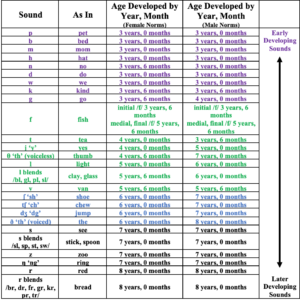
To determine the impact of articulation errors, a child’s intelligibility level should be considered. Meaning how well they are understood by others. Below are the expected intelligibility levels by age according to Pena-Brooks, Adriana, & Hedge:
- 2 years: Unfamiliar listeners should understand 50% of utterances at the sentence level
- 3 years: Unfamiliar listeners should understand 75% of utterances at the sentence level
- 4 years: Unfamiliar listeners should understand 75-90% of utterances at the sentence level
- 5+ years: Unfamiliar listeners should understand 90-100% of utterances at the sentence level
What should we do if a child says sounds incorrectly?
Find a Speech-Language Pathologist (SLP) to complete a full speech/language evaluation. The SLP will determine if your child’s speech and language skills are age-appropriate or recommend therapy to address a speech sound disorder.
The exact cause of speech sound disorders is unknown but they likely are not linked to one contributing factor. The most common risk factors:
- Recurrent ear infections in early childhood
- A parent or sibling that has/had a speech sound disorder
What will articulation therapy look like?
The most commonly used technique to address speech sounds is what is called the “Traditional Articulation Hierarchy.” Individual sounds are first taught and then practiced in short utterances gradually moving to longer utterances and spontaneous speech. The 7 levels are:
Syllables :
Conversation:.
View my Articulation Digital Cards HERE .
What if the client continues to have difficulty?
In any of the levels listed above, the client may have more difficulty compared to the others. This is quite normal. Target sounds are impacted by consonants and vowels that both precede and follow them. These are constantly changing as the target sound is used in new words, phrases, and sentences. If a client is having difficulty with a specific word, the SLP can have the client work back down the levels while practicing the target and then work back up.
The SLP may also try verbal, visual, or tactile cues to help the client produce or remember the sound. Techniques and examples include:
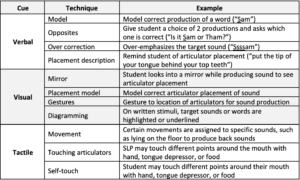
What can be done at home to help with sound production?
The most important thing for caregivers to do is to model the sound/words correctly at home. You can restate the word to the child while emphasizing the sound they produced incorrectly. Do not imitate what the child is saying. Sometimes adults think it’s cute to imitate how a child mispronounces words and even add it to everyday vocabulary. This will only reinforce their incorrect productions.
The SLP will most likely give homework once the client has mastered the sound and can successfully practice with others. Stick to the homework that is given to avoid working on words or levels that are too difficult for the client and may lead to frustration.
Building the client’s phonological awareness skills (listening skills) will also improve speech production. Ways to build phonological awareness skills are to:
- Play rhyming games: Give the client a word and have them think of as many words, both real and non-sense, that rhyme as they can.
- Practice opposites: Using a list of target words from the SLP, say each word correctly – incorrectly- correctly.
- Be the client: Using a list of target words from the SLP, say some of the words incorrectly and have the client correct you.
- Auditory Bombardment: Read books aloud to the client and point out words that contain their target sound. Exaggerate your production of the sound while saying the words aloud.
In summary, there is no specific timeline or technique for articulation therapy. Each client will progress at his or her own pace. It’s important to be consistent with practice and keep the therapy fun and engaging!
For information on parts of a speech-language evaluation, read my blog post An Oral Periph Exam.
- Pingback: Vowels of General American English - Global Speech Therapy
- Pingback: Articulation Therapy Techniques for Tricky Words - Global Speech Therapy
Leave a Reply Cancel reply
Your email address will not be published. Required fields are marked *
Save my name, email, and website in this browser for the next time I comment.
Any call to action with a link here?

Complex Following Directions Activities for Speech Therapy
Are you an SLP trying to work on following complex directions in speech therapy with your older students? Teaching 3rd, 4th, and 5th graders the importance of listening closely to spoken instructions has been an area I have consistently focused on in speech and language therapy . This is such an important classroom – and life- skill.
So, how do you make working on this skill area fun- and help your students see how important it really is to stop and listen closely? In this blog post, I’ll provide you with 3 actionable steps to make teaching following complex directions a breeze in speech therapy.

Step 1: Make Following Complex Directions a CHALLENGE
The key is to make it a challenge . My upper elementary students are so competitive , and I needed to use that to my advantage. The trick was making sure the directions included plenty of higher-level concepts and vocabulary , and that the activity itself wasn’t seen as “babyish”.
The answer: a following directions challenge .
These direction challenges could be used in individual therapy sessions, but they were also great in mixed groups. I passed out the bottom half of the papers to each student. My students had pencils ready in hand, waiting for me to tell them the direction.
I would say the direction, and the students would follow them. After completing the task, they’d look around the table- and notice that not everyone had completed the activity in the same way.
For example, I’d stated in the direction that they needed to write their name in the top left corner- but they immediately noticed when one had written their name in the top right corner instead.
I reminded my students: it wasn’t necessarily who could follow the direction the fastest. This complex multistep following directions challenge was more about who listened closely to all of the small, but important, pieces of information included in the task.
My students weren’t just learning to follow directions- they were also learning to focus.
Step 2: Include a variety of complex direction following concepts
There are several concepts and embedded vocabulary that you will want to target for your students that need support with following directions that are perfect for speech therapy . For example, I made sure to include temporal directions (i.e. such as before, after). Time vocabulary can be very tricky for my students. But temporal concepts aren’t the only important concepts you’ll want to address to make your following directions activity “complex”.

Temporal and Sequential Directions for Speech Therapy
Temporal concepts- or time concepts – can be so confusing for my students. These include terms such as before and after. Sequential concepts include understanding the correct order of events for information.
Temporal and sequential concepts are important for our students to understand.
An example of how I target temporal and sequential concepts in speech therapy using this complex following directions activity: “Before you circle the third A, underline the second A.”
A little while later, I’ll give a similar direction, but I’ve changed WHERE I use the word “before” in the sentence: “Point to the third A before you understand the second A.”
The meaning of the sentence can change completely, depending on where the temporal or sequential vocabulary term is used. This is such an important thing to remember when teaching temporal and sequential concepts, and understanding it requires lots of practice and exposure.
Spatial Directions for Speech Therapy
Following spatial directions requires the understanding of spatial concepts (aka location concepts). It is understanding the positioning of an object, and the relationship of that object to something else.
For younger students, we start by teaching spatial concepts like above, below, behind, and in front of. But by 4th grade, we need to make things a little more complex.
I always start by making sure my students understand the difference between right and left . Most of them don’t.
I then throw in some multiple modifiers to make things a little more complex.
Sure, my student knows how to write their name at the top of the page. But things are a little trickier when they have to write their name in the top left corner of the page. My students often fail to hear all of the components in a direction that contains multiple modifiers .
An example of how I incorporate spatial concepts into complex directions (containing other embedded concepts) would be: “First, write the month in the top right corner of the page. Next, circle the last letter.”
Conditional Directions for Speech Therapy
Conditional concepts can be tricky for our speech therapy students to comprehend. What are conditional concepts? They involve the understanding of “if”. Understanding how “if” can change the meaning of a sentence is very important. It allows the student to know what might happen- or what might not happen.
If we get five feet of snow tonight, we’ll get a snow day tomorrow.
It’s not a guarantee- and if you only get two inches of snow, you better make sure to grab your bookbag.
An example of how I incorporate complex conditional directions in speech therapy would be: “If today is Tuesday, circle the K. If not, underline the L.”
Working your way up to compex directions
Your student might not be at the level of complex yet- but they’re past the level of beginner.
You’ll need to provide leveled instruction.
Some of my students need a little more support initially, so I start by giving them written directions as well as spoken directions . I explain, “This direction is going to contain a time vocabulary word- ‘before’. You have to listen closely so that you know the order I want you to follow this direction in.”

We’d do a quick review of the time vocabulary being targeted:
“Clap your hands before you touch your nose.” My student would complete this task.
“Great. Now, Touch your nose BEFORE you clap your hands.”
We reviewed how the placement of the time vocabulary word in the sentence could change the meaning of the sentence.
Following this, we would highlight any target words that were difficult for them to recall and interpret in the direction.
Step 3: Make Your Direction Following Challenge Quick and Easy to Use During Speech Therapy
These complex following directions pages are super easy to store. I keep mine in a binder- but I also keep several extra copies on hand for “grab ‘n go” resources to use in therapy.
These directions activity worksheets are also super easy to modify.
Let’s say you don’t want to provide the written directions. No problem.
To work on following spoken directions only , I simply cut off the bottom of the page. I gave this to my students, then I kept the top part. Simple and easy, and great for data collection in a group. I just wrote their initials next to the direction, then had a quick “check” or “minus” data collection system.
Additional Uses for these Following Direction Challenge Activities
I have used these complex following directions challenges in several ways in speech therapy.
They make an excellent activity to use in individual therapy or small group therapy. It is easy to collect data using these sheets. You can use one as a warm-up, or combine several worksheets for an entire session targeting following complex directions.
These directions sheets also provide an easy way for me to gather data for the present levels section of an IEP when I’m planning to focus on complex directions objectives . I can get a percentage of accuracy, then re-assess several months later.
They also provide easy homework to send home for speech and language carryover practice.
No matter what, you’ll find these complex directions challenges becoming a “must-have” essential in your speech therapy room.

These worksheets offer a simple way to build complex listening skills and confidence with following directions tasks. They give upper elementary students the opportunity to practice following directions with a variety of embedded concepts.
They allow SLPs to have a grab ‘n go option to take students to that next level with following directions.
These following directions worksheets are challenging, fun and effective . My students have had a BLAST, and I’ve been amazed at the progress they have made in therapy.
Click here to grab these complex directions worksheets today!
Talk soon–
Similar Posts
Teletherapy speech therapy games and motivators.
Many of us are looking for teletherapy speech therapy resources or distance learning ideas. Here in Ohio, the school buildings are shut down for the remainder of the 2019-2020 academic year- but the learning is continuing online. Like many SLPs, I’m figuring this out as I go. I wanted to share a collection of ideas…

8 Fun Language and Articulation Printable Worksheets (that Students Love)
Speech pathologists looking for articulation printable worksheets should check out this blog post! It contains recommendations for speech and language worksheets that will allow SLPs to easily target a variety of articulation sounds during a speech therapy session, as well as language goals! Receptive and Expressive Language Worksheets for Speech Therapy Want some speech therapy…
Simple List of 15 Words That End With Z
Are you an SLP, teacher, or intervention specialist looking for a complete list of words that end with z? Or perhaps you enjoy playing word games? This blog post contains a word list you can use in speech therapy, with students in small groups, or even while playing wordle-like games! This post contains affiliate links,…
Thumb Sucking: What the Speech- Language Pathologist NEEDS to Know
I’m sure as an SLP you have been in the position I was in earlier this summer. I was working with a patient who had a lisp. It wasn’t necessarily always interdental (i.e. tongue sticking through his teeth), but his /s/ and /z/ sounds just didn’t sound crisp. I am a bit of a perfectionist…
Christmas Speech Therapy Activities: Themed Speech and Language Ideas
The holidays are nearly here, so I wanted to share some fun Christmas speech therapy activities we’ve been up to in my speech and language therapy room! I’ve got TONS of therapy ideas for you, so make sure to keep reading and pin this post for later! This is certainly the most wonderful time of…
Read This Quick List of 9 Neither Nor Sentences Examples
Are you a speech-language pathologist, intervention specialist, or teacher searching for neither nor sentences examples? This blog post defines correlative conjunctions. It provides example sentences using a variety of different correlative conjunctions, as well as different ideas for teaching conjunctions. Understanding how to use conjunctions isn’t just important for formal writing skills. This is an…
- WV App Login
- Site Search
- Report Templates
- Speech Helpers
- SLP Resources
- Top 10 Tips
- Getting an Eval
- Certified SLP
- How to Say the R Sound
- 0-18 Months
- 18-36 Months
- 18-30 Months
- 30-36 Months
- 10-11 Years
- Articulation
- Cleft Palate
- Phonological
- Dysphagia Causes
- Dysphagia Treatment
30 Problem Solving Scenarios for Speech Therapy Practice
As promised here are the words for your unlimited use .
If you know others who can use our lists ...
... please share this page using our site share buttons.
Explore Our Goal Reaching, Client Centered Products

SEE ALSO: Houston We Have a Problem! Activities for Problem Solving
Problem solving scenarios.
- Your friends came over to your house for a movie night. One of your friends brought another friend so there are more people than you planned for. You want to pass out the drinks but you only have five cans of soda and you need 6 for everyone to have one. What could you do?
- After basketball practice you go back to the locker room with your team to shower and change. When you are done dressing, you can't find your shoes. What could you do?
- You have been waiting all day for lunch to come because you are starving. Finally class gets over and you get to go to lunch. Except when you go to get to your lunch, it's not there. You probably left it at home. What could you do?
- There is a guy in your class who is always mean to you. He always bumps you when he walks by and he calls you names. He knocks stuff out of your hands and makes you feel stupid. You don't think you can take it anymore. What could you do?
- You really want to invite this new girl/guy to come to your birthday party, but you have never talked to them before. You are worried they will say no. What could you do?
- You rode the bus to school today and on the way in people are pointing and laughing at you. You go in the bathroom and see that you have pink gum all over the back of your pants. What could you do?
- You wake up and see that your alarm never went off. So you are starting your morning 15 minutes later than you planned. It is a really important day at school and you cannot be late. What could you do?
- You are giving a group presentation in front of class and it's your turn to talk. All of the sudden you sneeze. You cover it with your hand, but now your hand is full of stuff you sneezed out. What could you do?
- You are eating dinner at a fancy restaurant with your parents and their friends. You have a really messy dinner and accidentally flip a noodle into the lady's lap. They are busy talking and don't notice it. What could you do?
- You are taking a test and there is no talking allowed. You are writing your answers on the paper and your pencil breaks. What could you do?
- You are taking a test and the guy behind you asks you for help. He wants to know what you put for question number two. What could you do?
- You are at a birthday party and you have waited in line for a long time for your turn to hit the pinata. It is finally going to be your turn and it looks like the next hit will break the pinata. But you suddenly have to go to the bathroom. What could you do?
- You are hanging outside with your friend and she decides to pick your neighbor's flowers. She gives you the pretty handful of flowers and right then your neighbor opens the door. She asks you why you picked her flowers. What could you do?
- You borrowed your sister's skates one day without asking and they broke while you were using them. What could you do?
- You are eating at a friend's house and the mom piles your plate full of food. It looks really good and you want to eat it all but you can't because you just ate a snack. What could you do so you don't hurt her feelings?
SEE ALSO: The Best Free App for Speech Therapy

- Your teacher was working at her desk. You wanted to ask her a question, but she didn't see your hand raised. What should you do?
- You started to do your work, but you weren't sure if you were doing it right. What should you do?
- You were playing tether-ball and were the champion so far. In the next game, you slightly touched the rope. Only one student saw you touch the rope. What will you do?
- The teacher is giving directions, but your friend sitting next to you keeps talking. You can't hear the directions. What should you do?
- You didn't do your homework. Your teacher was upset with you. What should you do?
- You finished eating and felt a burp coming. What are you going to do?
- You were waiting to swing. When it was your turn, another boy jumped in front of you and took the swing. What would you do?
- You waited a long time, but your mom didn't come to pick you up after school. What should you do?
- A bully threatened to beat you up after school. What should you do?
- A boy on the playground keeps pushing you and making you mad. What would you do?
- You were sitting in class doing your work and you hear the fire alarm. What should you do?
- An adult you didn't know came on to the playground and asked if you would help look for his lost dog. What would you do?
- You forgot your lunch at home. What would you do?
- The person sitting behind you keeps tapping your chair with his foot. What should you do?
- You finished your work early. What should you do?
This list of functional words was professionally selected to be the most useful for a child or adult who has difficulty with problem solving scenarios.
We encourage you to use this list when practicing at home.
Home practice will make progress toward meeting individual language goals much faster.
Speech-Language Pathologists (SLPs) are only able to see students/clients 30-60 mins (or less) per week. This is not enough time or practice for someone to handle Problem solving scenarios.
Every day that your loved one goes without practice it becomes more difficult to help them.
SEE ALSO: The Best Books for Speech Therapy Practice

We know life is busy , but if you're reading this you're probably someone who cares about helping their loved one as much as you can.
Practice 5-10 minutes whenever you can, but try to do it on a consistent basis (daily).
Please, please, please use this list to practice.
It will be a great benefit to you and your loved one's progress.
Freebies, Activities, and Specials, Oh My! Sign up for Terrific Therapy Activity Emails
See Past Email Examples
Your information is 100% private & never shared .

Hi! We're Luke and Hollie.
We are both MS CCC-SLPs and fell in love while studying for our degrees. Since then we have done everything together - graduated, worked, and started a family. We spend most of our time with our family and the rest making this site for you.

Top Free Resources

Word Vault Essential

# 1 Chronological Age Calculator

Popular Materials
All in one printable flashcards.

Multiple Meaning Word Mega Pack

Complete Articulation Word Search

New! 111 Articulation Stories

Teaching the Sound Books

Multi-Syllabic Words Flashcards

Apps to Save You Time & Help Your Clients
Articulation therapy + pirate adventures = awesomeness.

This App Will Get Your Kids Talking

Image Credits
Copyright © 2010 –
HomeSpeechHome.com | All Rights Reserved

This website contains affiliate links, meaning if you buy something from them we may make some money (at no cost to you). By using our affiliate links, you are helping to support our site which is a U.S.-based, family-run small business :)

IMAGES
VIDEO
COMMENTS
7. Browse The Web. Review how to open web browsers, use search engines like Google, check email, and close tabs. Even these seemingly simple tasks can be life-changing for motivated patients. 8. Update a Calendar. An ongoing practical cognitive task for patients is updating their calendars.
If you are looking for speech therapy materials with inferencing picture scenes using evidence-based strategies, make sure to check out my Inferencing and Predicting Using Real Pictures for Speech Therapy.It includes 100 real life picture card scenarios that allow you to provide effective, direct teaching on how to make inferences from picture scenes (also available in Google Slides format for ...
Use problem-solving strategies when learning to use a smart speaker. Create a worksheet to help teach the steps. SET AN ALARM. SET A TIMER. SET REMINDERS. ADD AN APPOINTMENT TO A CALENDAR "Set a speech therapy appointment for every Monday at 10 am" CHECK A CALENDAR "When is Mother's Day?" SPELLING. CALCULATIONS
in brain injury: Collaboration between speech-language pathology and neuropsychology for an integrative neuropsychological perspective. Brain Injury, 26 (13-14), 1549-1563. Kennedy, M.R.T, & Coehlo, C. (2005). Self -regulation after traumatic brain injury: A framework for intervention of memory and problem solving.
multifactorial problem solving (i.e., complex problem solving); and; advanced Theory of Mind skills (e.g., perspective-taking). EF depends on foundational cognitive functions working together. Such cognitive functions include, but are not limited to, attention, processing speed, and; memory. EF deficits are a breakdown of any of these skills at ...
Here are some of my tips for teaching problem solving skills to students in speech therapy. Tip #1 for Teaching Problem Solving. Understand the process. Successful problem solving is a process that begins with identifying that there is a problem, thinking through possible solutions, and then selecting and implementing the best solution to that ...
Through various speech therapy techniques, individuals can develop the necessary communication skills to express their thoughts, understand others, and work collaboratively to solve problems. Speech Therapy Techniques that Promote Problem-Solving Skills. Speech therapists use a range of techniques to promote problem-solving skills. These ...
The prompting hierarchy is a structured, systematic method of assisting a person in learning new skills. It outlines the different ways we motivate our students to get the correct answer or achieve their goals. Prompt hierarchies provide many opportunities for communication. There are two different types of hierarchies: Most-To-Least and Least ...
Speech therapists can work with individuals to apply their problem-solving skills in everyday scenarios, such as resolving conflicts with peers, making decisions, and navigating social interactions. 1. Improved communication skills: By addressing problem solving in speech therapy, individuals develop stronger communication skills.
Effective problem solving consists of several key components: Identifying the problem: Recognizing and defining the issue at hand. Generating possible solutions: Brainstorming and considering different options. Evaluating and selecting the best solution: Assessing the pros and cons of each option and choosing the most appropriate one ...
AMERICAN JOURNAL OF SPEECH-LANGUAGE PATHOLOGY (AJSLP) JOURNAL OF SPEECH, LANGUAGE, AND HEARING RESEARCH (JSLHR) ... unable to remember what was just taught, and struggling with problem-solving, planning and organizing materials, and adhering to a schedule. ... He supports SLPs through SLPImpact and is a lead writer for The Speech Therapy Blog ...
Studies indicate that college students with ADHD, for example, are at a much higher risk for academic probation, leaving college without a degree, and experiencing financial problems in adulthood. From our clinical experiences, there are a few time points when executive function difficulties become more obvious.
Inferencing + Predicting. Inferencing and predicting skills (along with background knowledge, vocabulary, and syntax) are a key component of language comprehension. These skills facilitate the ability to understand and interpret information that isn't directly stated which deepens a student's comprehension of verbal, written, and/or social ...
This revised handout explains the importance of analogical reasoning skills and offers suggestions for teaching the hierarchy of analogical problem-solving sub-components to language impaired children. It lists the "Language Processing Hierarchy Pertaining to Critical Thinking" (Richard, 2001) as well as lists several FREE problem-solving apps and worksheets. References are provided.
6. Given a real-life or role-play conflict scenario, STUDENT will remain calm and relaxed, listen to the other person, and determine what they can agree on with 80% accuracy in 4 out of 5 opportunities. 7. Given criticism or feedback, STUDENT will look at the person, say "okay", and not argue with 80% accuracy in 4 out of 5 opportunities. 8.
A. Definition and Purpose of Speech Therapy. Speech therapy, also known as speech-language therapy, is a specialized form of therapy that focuses on assessing, diagnosing, and treating communication disorders. The primary goal of speech therapy is to improve an individual's ability to communicate effectively, both verbally and non-verbally.
Difficulties in problem-solving can impact an individual's social-emotional well-being, leading to frustration, low self-esteem, and interpersonal conflicts. Role of Speech Therapy in Enhancing Problem-Solving Abilities. Speech therapy is a holistic approach that addresses communication and cognitive-linguistic skills.
The common core requires that children are able to make inferences. Here are some ideas for teaching making inferences from what you read and see.
The patient will complete moderate problem-solving tasks r/t money management (e.g., calculating totals, calculating days until bills are due) at 80% accuracy given intermittent moderate verbal and minimal written cues in order to increase independence during functional problem-solving tasks.
Goal Bank for speech therapists working in a skilled nursing facility. Goals for Cognition, Memory, Attention, Problem Solving, Aphasia, Dysarthria, Voice, Swallowing, Tracheostomy, and Skilled Maintenance. For an all in one download please see end of document. ST Goal Bank Cuing Hierarchy Independent Setup/cleanup assistance Supervision or touching assistance Partial/mod assist Substantial ...
What will articulation therapy look like? The most commonly used technique to address speech sounds is what is called the "Traditional Articulation Hierarchy." Individual sounds are first taught and then practiced in short utterances gradually moving to longer utterances and spontaneous speech. The 7 levels are: Isolation:
An example of how I target temporal and sequential concepts in speech therapy using this complex following directions activity: "Before you circle the third A, underline the second A.". A little while later, I'll give a similar direction, but I've changed WHERE I use the word "before" in the sentence: "Point to the third A before ...
Speech-Language Pathologists (SLPs) are only able to see students/clients 30-60 mins (or less) per week. This is not enough time or practice for someone to handle Problem solving scenarios. Every day that your loved one goes without practice it becomes more difficult to help them. SEE ALSO: The Best Books for Speech Therapy Practice